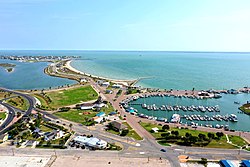Rockport, Texas | |
|---|---|
 | |
| Nickname: The Texas Riviera | |
 Location of Rockport, Texas | |
 | |
| Coordinates: 28°2′55″N97°2′28″W / 28.04861°N 97.04111°W | |
| Country | United States |
| State | Texas |
| County | Aransas |
| Incorporated | August 18, 1870 [1] |
| Government | |
| • Mayor | Lowell Timothy Jayroe |
| Area | |
• Total | 21.09 sq mi (54.63 km2) |
| • Land | 16.54 sq mi (42.85 km2) |
| • Water | 4.55 sq mi (11.78 km2) |
| Elevation | 6.6 ft (2 m) |
| Population (2020) | |
• Total | 10,070 |
• Estimate (2021) | 10,436 |
| • Density | 608.7/sq mi (235.0/km2) |
| Time zone | UTC-6 (Central (CST)) |
| • Summer (DST) | UTC-5 (CDT) |
| ZIP codes | 78381-78382 |
| Area code | 361 |
| FIPS code | 48-62804 [3] |
| GNIS feature ID | 1345420 [4] |
| Website | www |
Rockport is a city and county seat of Aransas County, Texas, United States. The population was 10,070 at the 2020 census.
Contents
- History
- 19th Century
- 20th Century
- 21st Century
- Geography
- Climate
- Demographics
- 2020 Census data
- 2018 Census data
- Arts and culture
- Area attractions
- Library
- Parks and recreation
- The Big Tree
- Rockport Beach Park
- Boating and marinas
- The Big Blue Crab
- Birdwatching
- Education
- Public schools
- Notable people
- Notes
- References
- External links
Rockport is adjacent to the town of Fulton, and many refer to the combined communities as "Rockport-Fulton"; however, Rockport and Fulton are legally separate municipalities.



